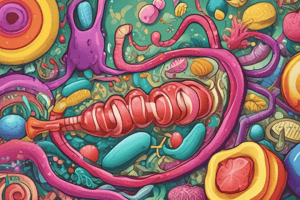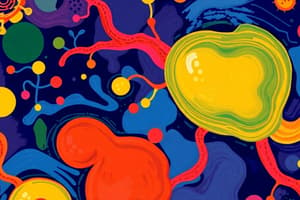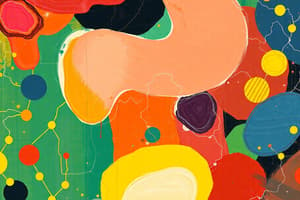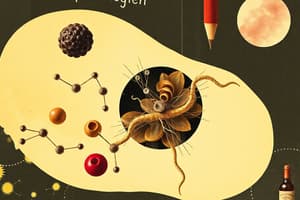Podcast
Questions and Answers
What is the primary site of lipid digestion?
What is the primary site of lipid digestion?
- Stomach
- Small intestine (correct)
- Mouth
- Large intestine
What is the function of bile salts in lipid digestion?
What is the function of bile salts in lipid digestion?
- Storage of lipids in adipose tissue
- Emulsification of lipids in the small intestine (correct)
- Breakdown of triglycerides into fatty acids
- Absorption of lipids into the bloodstream
What is the role of gastric lipase in lipid digestion?
What is the role of gastric lipase in lipid digestion?
- Absorption of lipids into the bloodstream
- Breakdown of some fat before it enters the duodenum (correct)
- Breakdown of proteins into amino acids
- Breakdown of carbohydrates into simple sugars
What is the effect of cholecystokinin (CCK) on the gallbladder?
What is the effect of cholecystokinin (CCK) on the gallbladder?
What is the result of the breakdown of triglycerides during lipid digestion?
What is the result of the breakdown of triglycerides during lipid digestion?
What is the role of salivary lipase in lipid digestion?
What is the role of salivary lipase in lipid digestion?
What is the function of pancreatic lipase in lipid digestion?
What is the function of pancreatic lipase in lipid digestion?
What is the importance of the small intestine in lipid digestion?
What is the importance of the small intestine in lipid digestion?
What is the primary function of lipoprotein lipase in the capillaries?
What is the primary function of lipoprotein lipase in the capillaries?
What happens to the remnants of chylomicrons after 10-12 hours of circulation?
What happens to the remnants of chylomicrons after 10-12 hours of circulation?
What is the primary destination of chylomicrons after absorption in the small intestine?
What is the primary destination of chylomicrons after absorption in the small intestine?
What is the role of bile salts in lipid digestion?
What is the role of bile salts in lipid digestion?
What is the purpose of enterohepatic circulation?
What is the purpose of enterohepatic circulation?
What is the product of pancreatic lipase digesting triglycerides?
What is the product of pancreatic lipase digesting triglycerides?
Why is fat a more concentrated source of energy than carbohydrates?
Why is fat a more concentrated source of energy than carbohydrates?
What happens to cholesterol during lipid digestion?
What happens to cholesterol during lipid digestion?
What is the primary function of adipose cells?
What is the primary function of adipose cells?
What is the role of micelles in lipid absorption?
What is the role of micelles in lipid absorption?
What happens to glycerol molecules when they are released from adipose cells?
What happens to glycerol molecules when they are released from adipose cells?
What is the difference between medium-chain triglycerides (MCTs) and long-chain triglycerides (LCTs)?
What is the difference between medium-chain triglycerides (MCTs) and long-chain triglycerides (LCTs)?
Why does consuming too much energy from protein and carbohydrates contribute to unwanted weight gain?
Why does consuming too much energy from protein and carbohydrates contribute to unwanted weight gain?
What happens to short- and medium-chain fatty acids after absorption?
What happens to short- and medium-chain fatty acids after absorption?
What happens to the fat in a piece of fried chicken as it undergoes digestion and absorption in a healthy person's intestinal tract?
What happens to the fat in a piece of fried chicken as it undergoes digestion and absorption in a healthy person's intestinal tract?
What is the purpose of chylomicrons?
What is the purpose of chylomicrons?
What is the role of bile in lipid digestion and absorption?
What is the role of bile in lipid digestion and absorption?
What is the final step in lipid absorption?
What is the final step in lipid absorption?
Why are medium-chain triglycerides (MCTs) used in the treatment of certain medical conditions?
Why are medium-chain triglycerides (MCTs) used in the treatment of certain medical conditions?
What is the percentage of dietary cholesterol that is typically absorbed by the small intestine?
What is the percentage of dietary cholesterol that is typically absorbed by the small intestine?
Flashcards are hidden until you start studying
Study Notes
Lipid Digestion
- Lipid digestion is a more complicated process compared to sugars and starches
- Triglycerides and phospholipids need to be broken down by special enzymes called lipases before they can be absorbed
- Salivary lipase in saliva mixes with food and breaks down lipids in the mouth
- Gastric lipase in the stomach breaks down some fat before it enters the duodenum
- The small intestine is the primary site of lipid digestion
CCK and Bile Salts
- Cholecystokinin (CCK) stimulates the gallbladder to contract and release bile
- CCK also signals the pancreas to secrete digestive enzymes, including pancreatic lipase, into the duodenum
- Bile salts enhance digestion and absorption by keeping lipids dispersed in the watery environment of the small intestine (emulsification)
Role of Bile in Lipid Digestion
- Bile salts surround lipid particles, forming micelles, which reduce the size of large fat droplets and increase the surface area of lipids
- Pancreatic lipase gains greater access to lipid molecules and digests them more readily
- If bile is not secreted into the duodenum, lipids in chyme clump together, making lipid digestion less efficient
Intestinal Enzyme Action
- Pancreatic lipase digests triglycerides by removing two fatty acids from each triglyceride molecule, converting them into monoglycerides
- Phospholipase digests phospholipids, removing two fatty acids from a phospholipid molecule
- Glycerol, fatty acids, monoglycerides, and phospholipid fragments are the end products of lipid digestion
Lipid Absorption
- Micelles transport fat-soluble end products of digestion to villi in the small intestine
- Fatty acids, monoglycerides, and cholesterol leave micelles and move into villi
- The small intestine digests and absorbs nearly all triglycerides and phospholipids in food, but only about half of dietary cholesterol is absorbed
Lipid Transport and Elimination
- Chylomicrons are formed in the small intestine and transport lipids through the bloodstream
- Lipoprotein lipase breaks down chylomicrons into fatty acids and glycerol
- Nearby cells pick up fatty acids and glycerol molecules to use for energy
- The liver clears cholesterol-rich remnants from the bloodstream and uses their contents to synthesize new lipids and lipoproteins
Recycling Bile Salts
- Most bile salts are absorbed in the ileum and reused by the liver to make new bile
- Enterohepatic circulation is the process of recycling bile salts
- Interfering with enterohepatic circulation can reduce blood cholesterol levels
Using Triglycerides for Energy
- Most cells can metabolize fatty acids for energy
- Adipose cells store triglycerides for energy and reassemble them into fatty acids and glycerol when needed
- The liver converts excess glucose and certain amino acids into fatty acids, contributing to triglyceride synthesis
Studying That Suits You
Use AI to generate personalized quizzes and flashcards to suit your learning preferences.




